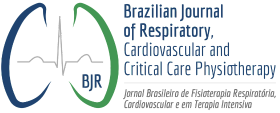Função Pulmonar de pacientes submetidos a Cirurgia Bariátrica
Pulmonary function in patients undergoing Bariatric Surgery
Alexandre Ricardo Pepe Ambrozin, Roberta Munhoz Manzano, André Luiz dos Santos, Robison José Quitério
Resumo
Introdução: A obesidade é considerada um fator de risco para complicações pulmonares pós-operatórias. A cirurgia bariátrica tem sido utilizada como recurso terapêutico no tratamento da obesidade mórbida. Objetivo: Avaliar a função pulmonar de pacientes obesos mórbidos candidatos à cirurgia bariátrica. Métodos: Os pacientes foram submetidos à prova de função pulmonar, por meio da espirometria e manovacuometria, e foram avaliados a capacidade vital lenta e forçada (CVL e CVF), volume expirado forçado, no primeiro segundo (VEF1 ), relação VEF1 /CVF, fluxo expiratório forçado 25-75% (FEF25-75%) e pressão inspiratória e expiratória máxima (Pimáx e Pemáx). Resultados: 18 pacientes (4 homens e 14 mulheres), com idade média 37,33±11,23 anos, altura 1,65±0,09 metros, peso 125,92±25,24 kg e IMC de 46,34±9,20 kg/m2 , CVL 100,64±22,91%, CVF 102,04±21,82%, VEF1 104,85±22,16%, VEF1 /CVF 83,54±6,63% e FEF25-75% 84,47±25,74%, Pimáx de 99,75±24,55 cmH2 O e Pemáx 102,12±25,06 cmH2 O. Conclusões: Os pacientes candidatos à cirurgia bariátrica apresentaram espirometria e manovacuometria dentro da normalidade.
Palavras-chave
Abstract
Introduction: Obesity is a risk factor for postoperative pulmonary complications. Overweight can alter respiratory mechanics and decrease lung volumes and capacities. Bariatric surgery (BS) has been used as treatment for morbid obesity, but this surgery can lead to respiratory complications. Objective: To evaluate pulmonary function in morbid obese patients undergoing bariatric surgery. Methods: The patients were submitted to pulmonary function testing, including slow and forced vital capacity (SVC and FVC), forced expiratory volume in the first second (FEV1), Tiffenau index (FEV1/FVC), forced expiratory flow 25-75% (FEF25-75%) and maximal inspiratory and expiratory pressure (MIP and MEP). Descriptive analysis was performed. Results: We evaluated 18 patients, mean age of 37.33 ± 11.23 years, height 1.65 ± 0.09 m, weight 125.92 ± 25.24 kg and BMI 46.34 ± 9 20 kg/m2 , SVC 100.64 ± 22.91%, FVC 102.04 ± 21.82%, FEV1 104.85 ± 22.16%, FEV1 /FVC 83.54 ± 6.63% and FEF25-75% 84.47 ± 25.74%, 99.75 ± 24.55 for MIP and MEP 102.12 ± 25.06 cmH2O. Conclusion: The bariatric surgery candidates had normal values for manovacuometry and spirometry
Keywords
References
1. WHO. Available from: http://www.who.int/gho/ncd/risk factors/overweighttext/en/index.html
2. Guimarães C, Martins MV, Santos JM. Função pulmonar em doentes obesos submetidos a cirurgia bariátrica. Rev Port Pneumol. 2012;18(3):115-9.
3. Siafakas NM, Mitrouska I, Bourus D, Georgopoulos D. Surgery and the respiratory muscles. Thorax. 1999 May;54(5):458-65.
4. Saad IAB, Capitani EM, Toro IFC, Zambon L. Clinical variables of preoperative risk in thoracic surgery. São Paulo Med J. 2003 May 5;121(3):107-10.
5. Doyle RL. Assessing and modifying the risk of postoperative pulmonary complications. Chest. 1999 May;115(5Suppl):77-81.
6. Smetana MD, Gerald W. Preoperative pulmonary evaluation. New Engl J Med. 1999 Mar 25;340(12):937-44.
7. Filardo FA, Faresin SM, Fernandes AL. Validade de um índice prognóstico para ocorrência de complicações pulmonares no pós-operatório de cirurgia abdominal alta. Rev Assoc Med Bras. 2002;48(3):209-16.
8. Saad IAB, Zambom L. Variáveis clínicas de risco pré-operatório. Rev Assoc Med Bras. 2000;47(2):117-24.
9. Fuso L, Cisternino L, Napoli A, Dicosmo V, Tramaglino LM, Basso S, et al. Role of spirometric and arterial gas data in predicting pulmonary complications after abdominal surgery. Respir Med. 2000 Dec;94(12):1171-6.
10. Pereira ED1, Fernandes AL, da Silva Anção M, de Araúja Pereres C, Atallah AN, Faresin SM. Prospective assessment of the risk of postoperative pulmonary complications in patients submitted to upper abdominal surgery. São Paulo Med J. 1999 Jul 1;117(4):151-60.
11. Kips JC. Preoperative pulmonary evaluation. Acta Clin Belg. 1997;52(5):301-5.
12. Sociedade Brasileira de Pneumologia e Tisiologia. Diretrizes para Testes de Função Pulmonar. J Pneumol. 2002;28(3 Suppl):1-6,74-9.
13. Rezaiguia S, Jayr C. Prévention dês complications respiratoires aprés chirurgie abdominale. Annal Fr Anesthésie Réanimation. 1996;15(5): 623-46.
14. Kocabas A, Kara K, Özgür G, Sönmez H, Burgut R. Value of preoperative spirometry to predict postoperative pulmonary complications. Respir Med.1996 Jan;90(1):25-33.
15 Kearney DJ, Lee TH, Reilly JJ, Decamp MM, Sugarbaker DJ. Assessment of operative risk in patients undergoing lung resection. Importance of predicted pulmonary function. Chest. 1994 Mar;105(3):753-9.
16. Auler Junior JOC, Giannini CG, Saragiotto DF. Desafios no Manuseio Peri-Operatório de Pacientes Obesos Mórbidos:Como Prevenir Complicações. Rev Bras Anestesiol. 2003 Mar-Abr;53(2):227-36.
17. John L. Hankinson, John R. Odencrantz, And Kathleen B. Fedan. Spirometric Reference Values from a Sample of the General U.S. Population. Am J Respir Crit Care Med. 1999 Jan;159(1):179-87.
18. Knudson RJ, Lebowitz MD, Holberg CJ, Burrows B. Changes in the normal maximal expiratory flow-volume curve with growth and aging. Am Rev Respir Dis. 1983 Jun;127(6):725-34.
19. Black LF, Hyatt RE. Maximal respiratory pressures: normal values and relationship to age and sex. Am Rev Respir Dis. 1969 May;99(5):696-702.
20. Faintuch J, Souza SAF, Valezi AC, Sant’Anna AF, Gama-Rodrigues JJ. Pulmonary function and aerobic capacity in asymptomatic bariatric candidates with very severe morbid obesity. Rev Hosp Clin Fac Med S Paulo. 2004 Aug;59(4):181-6.
21. Aldenkortt M, Lysakowski C, Elia N, Brochard L, Trame MR. Ventilation strategies in obese patients undergoing surgery: a quantitative systematic review and meta-analysis. Br J Anaesth. 2012 Oct;109(4):493-502.
22. Costa TR, Lima TP, Gontijo PL, Carvalho HA, Cardoso FPF, Faria OP, Cavalcanti Neto FF. Correlação da força muscular respiratória com variáveis antropométricas de mulheres eutróficas e obesas. Rev Assoc Med Bras. 2010;56(4):403-8.
23. Domingos-Benício NC, Gastaldi AC, Perecini JC, Avena KM, Guimarães RC, Sologuren MJJ, et al. Influência do peso corporal sobre as pressões respiratórias máximas nas posições sentada, deitada e em pé. Rev Bras Fisioter. 2003;7(3):217-22.
24. Magnani KL, Cataneo AJM. Respiratory muscle strength in obese individuals and influence of upper-body fat distribution. Sao Paulo Med J. 2007 Jul 5;125(4):215-9.

